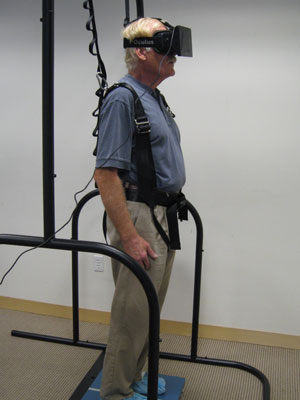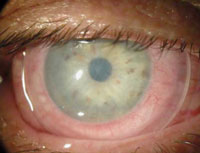People with glaucoma have a higher risk of falls, and a new high-tech test might help clinicians better understand the role balance control plays in this increased risk.
 | |
| Patient being evaluated with the virtual reality-based balance assessment test at the University of California San Diego Visual Performance Laboratory. |
Using virtual reality goggles and a platform that measures balance and movement, a multidisciplinary team based at the University of California San Diego (UCSD) studied 42 patients with open-angle glaucoma and 38 healthy subjects. The researchers recorded the subjects’ balance without stimulation, with a black screen using the goggles, and when presented with simulated movement. During simulated movement, they found balance adjustments for the glaucoma patients were an average of 30% to 40% more pronounced than the healthy subjects.1
In addition to the balance adjustment findings, they also found that “the degree to which balance was lost was strongly linked to a history of falls, which validated the study’s methods and metrics.” The results were published online in Ophthalmology.
“Measures from traditional static visual field tests do not mimic the visual conditions that occur day-to-day,” explained Felipe A. Medeiros, MD, senior author and director of the Visual Performance Laboratory at UCSD. “With further refinement of this method, we hope that the approach could one day be used to identify patients at high risk of falling so that preventative measures can be employed at an earlier stage.”
They were looking for a better way to document the correlation between visual field results and risk of falls in glaucoma patients. Previous research only shows a weak correlation, even though glaucoma patients’ risk of falling is more than three times greater than those without glaucoma.2
The researchers speculate that balance control issues in patients with glaucoma are related to the loss of retinal ganglion cells caused by the disease, leading to slower visual processing and impaired motion perception. They hope this testing method will spur new studies, ultimately helping eye care professionals better understand the relationship between risk of falls and retinal ganglion cell loss in people with glaucoma.
1. Diniz-Filho A, Boer ER, Gracitelli CPB, et al. Evaluation of postural control in patients with glaucoma using a virtual reality environment. Ophthalmology. 2015 April 15. [Epub ahead of print].2. Haymes SA, Leblanc RP, Nicolela MT, et al. Risk of falls and motor vehicle collisions in glaucoma. Invest Ophthalmol Vis Sci. 2007 Mar;48(3):1149-55.
Objections to Amniotic Membrane Use in Texas But the Texas Medical Association (TMA) and the Texas Ophthalmological Association (TOA), wrote a letter to the Texas Board of Optometry stating their concern that amniotic membrane use is beyond optometrists’ scope of practice because applying the membrane is considered surgery within Texas statute. Optometrists’ current scope of practice includes prescribing lenses, contact lenses and ocular pharmaceutical agents. Prokera should not be classified under these categories, Austin I. King, MD, TMA president, said in the letter. The Texas Optometry Board has not publicly responded to the letter. |


